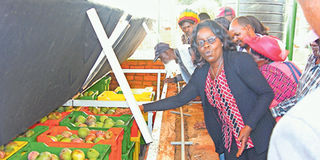Reduce fruit losses in these simple ways

Dr Jane Ambuko, a scientist at the University of Nairobi, explains to Masii mango farmers how to operate the brick cooler. Cold chain management is a standard practice for horticultural value chains in the developed world. FILE PHOTO | NMG
What you need to know:
- Harvested fresh fruits and vegetables are still ‘living’. This means they respire, transpire, are prone to injury and can be attacked by diseases.
- If not properly managed, these factors lead to fast deterioration of the produce after harvest and contribute to high post-harvest losses.
- Research has shown that for every 10 degrees Celsius increase in handling or storage temperature, the rate of spoilage goes up two to three times.
- Cold chain management is a standard practice for horticultural value chains in the developed world. It is often regarded as a complicated process that is out of reach for smallholder farmers.
It is estimated that 40 to 50 per cent of fruits and vegetables produced for consumption are lost along the supply chain.
Harvested fresh fruits and vegetables are still ‘living’. This means they respire, transpire, are prone to injury and can be attacked by diseases.
If not properly managed, these factors lead to fast deterioration of the produce after harvest and contribute to high post-harvest losses. At the centre of the factors that lead to spoilage of fruits and vegetables is temperature.
Research has shown that for every 10 degrees Celsius increase in handling or storage temperature, the rate of spoilage goes up two to three times.
Therefore, maintaining cool but safe temperature from harvest to the time the fruits and vegetables are consumed is key to preservation.
A cold chain for perishable commodities refers to handling the produce within a low safe temperature from harvest until it reaches the user.
For most fruits and vegetables of tropical origin, safe handling temperatures vary with different commodities but are generally above 10 degrees. Lower temperatures could result in chilling injury.
Cold chain management is a standard practice for horticultural value chains in the developed world. It is often regarded as a complicated process that is out of reach for smallholder farmers.
It is presumed that to maintain the chain, one must have access to conventional cold rooms and refrigerated transport.
In those countries, where horticulture is dominated by small scale producers with limited resources, a semblance of the cold chain can be realised through simple practices and post-harvest handling technology. Some are described below.
Time of harvest
This determines the field heat on the produce. Field heat refers to the heat on a crop immediately after harvest. It includes the heat absorbed from the environment before harvest and what is generated from the respiring crop.
If the crop is harvested during the hot times of the day, the levels of field heat are high. For instance, the pulp temperature of mango fruits harvested at 7am was found to average 16 degrees Celsius while those picked around 1pm averaged 33 degrees. The high heat load on the fruits hastens deterioration.
It takes time to remove the field heat from such produce. Harvesting during the cooler times of the day is therefore recommended.
On-farm Shading
It is common to find harvested produce heaped under a tree. However, a proper shade is preferred. It can be made from simple materials like grass and wooden poles.
Pre-cooling and temporary storage
Besides the shades, farmers are encouraged to adopt simple and low-cost cool storage technology such as zero energy brick cooler (ZEBC) and the charcoal cooler.
Their capacity can be adjusted. A simple ZEBC is made from a double wall of interlocked bricks. The cavity between the walls is filled with sand which is kept wet.
The evaporative charcoal cooler is made from a double wall made from chicken wire and packed with charcoal.
The evaporative cooling technology is ideal for temporary storage and especially in areas without access to reliable electricity.
Packaging for transport
The common practice employed to package fruits and vegetables among most smallholders is stuffing them in polythene sacks. This not only enhances mechanical injury on the produce during transportation but also encourages heat build-up and deterioration.
Packaging the fruits and vegetables in aerated containers such as crates is recommended. The containers can be cushioned with dampened newspapers which results in cooling as water evaporates. In some cases, ice or cool packs can be used in the crates to achieve the same effect.
Handling at the market
Efforts to ensure cool chain maintenance are in vain if the process is broken at the market stage. Traders should endeavour to maintain cool temperature of the produce. The display of produce in the open sun results in heat build-up.
Sellers can keep the bulk of their produce in the store and only display small volumes.
Simple shades should be used to protect the displayed produce from the direct sun. Sprinkling clean water over the produce has a cooling effect.
At the consumer stage
The consumer is expected to store the perishables are in a cool place. The best option is the refrigerator. However, without access to a fridge, the pot-in-pot evaporative cooling technology can be adopted.
Here, a small pot is put into a large one, leaving a cavity between them. The cavity is them filled with wet sand.
****
What to do
Harvest, shade and storage
Time of harvest determines the field heat of your fruits or vegetables. It is recommended that they be harvested when the day is cool.
After harvesting, the fruits should be put in some shade to allow them to cool. The farmer can make the shades using simple materials like grass.
Consumers should store the fruits in cool places. A refrigerator or a pot is recommended.




